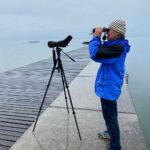In an area rarely visited by bird-watchers in the Three-Lakes region, an unringed immature female (baptised Vicky) was regularly observed from July 4 (although she was probably there earlier), and last seen on August 17. It seems that she left on migration around the middle of the month, but was so discreet that we don’t know exactly when.
A nice surprise was the visit, from July 29 to August 2, of another unringed female (this time an adult) in the same area. She had a distinctive plumage with a heavier collar and different underwing pattern (see photo above). While all three of our territorial males were observed visiting the area that these females were using, no display flight or other nuptial behaviour was noted – possibly due to Vicky still being immature.
Without being able to read a colour ring, or to compare each bird’s plumage from photos, it is very difficult to tell one Osprey from another. The challenge of recognizing local birds gets even greater when autumn migration is under way, with birds from elsewhere passing through Switzerland and sometimes stopping over for a few days.
To date our three males are still around: Arthur F12 (last seen in 2023 for sure on September 1, and possibly even until the 10th), Olympe F28 (last seen in 2023 on August 29), and Racine F29 (last seen in 2023 on September 5). All three are now getting ready to migrate soon!




























